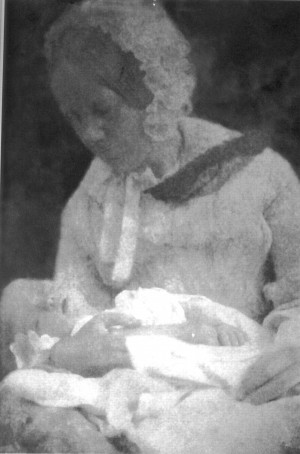![colors]()
I had to hear it from Wil Wheaton.
Talking to the creators of open-world hit game Uncharted on his show, Conversations with Creators, the geek legend praised a feature that helps you guide protagonist Nathan Drake around its vast, sprawling environment: “And I love there's that subtle yellow path," he said. "I never got lost!”
When I heard him, my eyes widened. I'd finished all three games in the series and never had any help from any “yellow path”! Do you have any idea how many hours I wasted wandering off and backtracking? Those are hours I'll never get back, Naughty Dog!
Why didn't I know about the yellow path? Because I never saw it. I was born with an extremely rare eye condition known as achromatopsia nystagmus.
It only affects 1 in 33,000 people. What it breaks down to is:
• near-sightedness
• no depth perception
• extreme light-sensitivity
• color-blindness
In brief, I have to look very closely at things in order to see them, and I only see black and white.1
At one point during a game, I stood atop a mountain crag, a huge chasm in my way. I know from my decades of playing video games that there must be a way to do it—I just can't figure it out. I don't wanna look it up, because I can sense it's a straightforward challenge.
I go this way. I go that way. I try this jump. I try that shimmy across the rocks. Nothing works. The death sequence plays over and over again. It adds up.
My wife wanders into the living room. “Oh, is this Uncharted?” I let her know that it'll be pretty boring, watching me die over and over. She watches for a second. “Are you supposed to go through the red areas?”
My heart sinks. She explains that there's a not-so-subtle spread of red bricks, reddish dirt, and other conspicuous indicators forming a path through the treacherous landscape. She points out one such area. Red is, incidentally, my favorite color. But here, I could barely make it out.
I crossed the chasm.
Uncharted is a fantastic game series; Naughty Dog is not the only offender. Enter sweet, infuriating Assassin's Creed.
Another open-world game series, it favors stealth over Unchartered's spectacular MacGyvering. I love it, but I don't love Eagle Vision, one of the distinctive features of play, often all-but necessary for your character to make progress.
Where I live in LA, the most reliable way for me to make progress is the bus. The bus sucks, because people don't wash, pick fights, and hate being there—and that's just the drivers. But I don't hate the bus as much as I hate Eagle Vision.
Eagle Vision made me nervous from the outset. It's one of those things that, for we disabled, sounds kinda cool, but comes with a sinking feeling that tells you it's just not going to work out.
The tutorial walked me through it: “Press R2 to turn on Eagle Vision. In Eagle Vision, you use your mad assassin observation skills to observe things other people don't notice.” I pressed R2. The tutorial continued: “Notice targets are in red, civilians are in yellow, potential enemies like guards are in blue.”
![eagle vision achromat']()
I dropped the controller.
“Aw, come on!”
It sucks, because my wife bought me this game for my birthday. I can't tell the difference between any of the people that Assassin's Creed has just helpfully color-differentiated for me. Sure, sometimes, the game zooms in on a character to let me know specifically whom I'm after, but the population at-large, the people I'm supposed to know about so I don't kill civilians, or piss off guards? I've no clue.
Fortunately, progress is still possible, though I imagine it's really handy—a fact attested to by the ridiculous number of times I must start over.
Even worse is Resident Evil 4, Capcom's survival horror epic.
It's hands-down among my top-10 favorite gaming experiences thanks to intense visuals, a creepily engaging story, and the satisfaction of shotgunning zombies and evil cultists. But one puzzle in it almost ended my joyful delirium before things had even gotten cooking: the church puzzle.
![church puzzle achromat]()
Early in the game, you're stuck in a church. To get out, you have to match symbols, each of which is—you've guessed it!—one of three different colors. I stared for a second and realized that this would be impossible. To a normally sighted person, it's a simple matter of organizing red, green and blue symbols in an easily-deduced pattern.
Not for me. I gave it an honest try. I guessed. Over and over. I probably spent close to half an hour trying to randomly get it right. Finally, I gave up and looked up the solution, and was back in action.
Solutions
I know what you're thinking. “Okay, Anton. We get it. Gaming while achromat is tough. Did you have any solutions?” Yes. Yes, I do. And the cool thing is that some solutions are so easy, AAA developers will facepalm for having not considered them before.
https://www.youtube.com/embed/ObGmrfeZuxs
In the puzzle game Sparkle 2, you shoot colored balls at other colored balls in an attempt to create combinations that pop away before the advancing mass of balls can overwhelm the player. I tried the game fully expecting to fail, but I had a blast because of a simple check-box: “Accessibility.”
Click it, and there are patterns on the balls! I was now matching patterns instead of colors. The developers, 10tons, didn't have to re-invent any wheels or start any revolutions. All they had to do was replace colors with patterns, and their game opened up for me.
https://www.youtube.com/embed/bmptTn_4ooc
This technique can't cure all accessibility ills, but just imagine if the church puzzle had given the symbols texture as well as color? I would've had a fair chance. Admittedly, such a technique wouldn't work as well with Uncharted or Assassin's Creed. But instead of a yellow line, there could be little arrow signs. Or, maybe, a subtle little rumble in the controller when the player's pointed the right way. Nintendo often throws in a help box after you've failed a level a few times: nothing too hand-holdy, but there if you need it.
Assassin's Creed is full of symbols, and more wouldn't hurt, especially if they were optional. Arrows float around pointing to nearby goals and story points, and above characters' heads now and again, so why not have Eagle Vision operate in a similar way? Maybe even give the disabled player the option to make all text and symbols really big so we can't possibly miss them.
None of these solutions would be perfect. But it is possible. It can happen.
1. I've spent my entire childhood, most of my teen years, and some of my adulthood going to eye doctors. In the early days, it was to figure out what was wrong with my eyes. More recently, it's to get official sign-off on government forms so I can get my disabled parking placard and other such necessities. I've learned in all these visits that, medically speaking, I only see black and white. I say “medically speaking” because, and I can't explain why this is, I feel like I see some color. While I am sometimes able to identify some colors, I can't distinguish between colors and groups of colors.
Anton A. Hill is a blind writer, lifelong gamer and accessibility advocate.







































